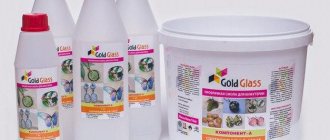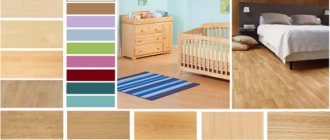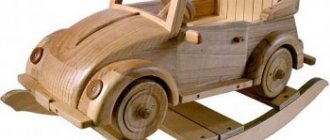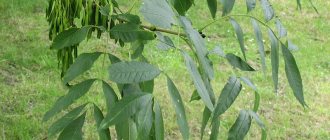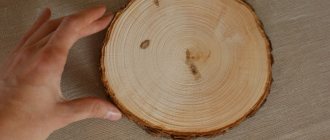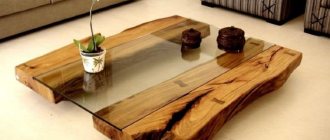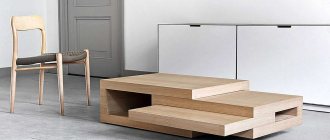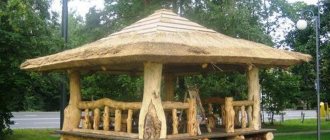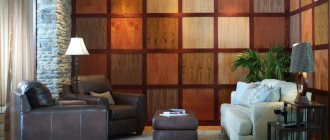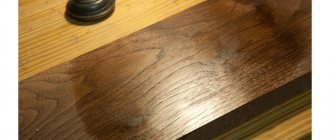Let's be honest, over the years of work, our clients often ask us the same questions, but among this cohort of questions, one in particular stands out, it is asked so often that we are already quite tired of answering it. This question torments many who are faced with a difficult choice - which solid wood to choose, and in general which wood is best for furniture. The problem is really not a joke, since there are about 25 thousand different types of wood around the globe. But only about 30 of them are used in construction and repair work of residential premises and houses, as well as in furniture production. Therefore, within the framework of this material, let’s still try to answer questions that are so important for us: “Which wood is best for furniture?”
And before we begin our excursion into the study of different types of wood, we need to find out what distinguishes them from each other, what characteristics have a special impact on the use of wooden furniture.
Features of different types of wood
Which wood to choose for furniture can only be understood after familiarizing yourself with the properties of different species. Here are the most popular:
- Maple is strong and heavy, easily painted in different shades.
Furniture made of maple wood with laconic facades is suitable for the loft style
- Rubber wood , for example, Hevea brasiliensis, is a lightweight material that is used to create cabinets, sofas and more.
Furniture made of rubber wood, despite its exotic origin, looks quite familiar
- Oak is hard, reliable and aesthetically pleasing. Under Peter I in Rus', cutting down these trees was strictly prohibited. And in our time, there are also state-protected oaks that are hundreds of years old. But they are also grown to create durable interior items.
Oak furniture can be elegant, like these unusual shelving
- Walnut is also a valuable wood suitable for furniture making. Its texture and color are non-uniform, so the surfaces turn out to be non-standard - with a complex pattern.
Walnut shelving is the main decoration of the room
- Mahogany is the wood of sandalwood, teak, and mahogany. It has red-brown tones.
Mahogany can have either a reddish undertone or a darker, almost brown tone.
- Mango has a beautiful texture and a wide range of shades - from pinkish to chocolate, with black and yellow stripes.
Mango is not only a delicious fruit, but also an excellent wood
- Acacia has durable dark brown wood that is scratch and water resistant.
Acacia furniture can even be placed by the pool
- Pine leads the ranking of the most popular and affordable wood suitable for the production of interior items. Finnish pine is more durable. This wood can be painted in any color.
If pine is used in its natural form, it should be coated with protective compounds - then it will remain the same light even after a long time
- Spruce has low resin content, which makes it suitable for finishing baths. Spruce furniture is simple and natural, and has a pleasant pine aroma.
A “feminine” spruce chest of drawers is suitable for country, Provence, boho and some other styles
- Birch is stronger than pine. It needs proper processing - its quality depends on it. It also needs to be protected from dampness. Usually things made from birch are painted, since in their natural form they look unfinished. Karelian birch is distinguished by its unusual pattern - it resembles the surface of marble - and is very highly valued.
An unusual multi-colored chest of drawers made of birch will enliven the interior
Usually more traditional furniture is made from Karelian birch, however, this modern chest of drawers is worthy of attention
- Ash is light, smooth and flexible. It is great for creating curved elements such as the backs of Viennese chairs.
The chairs are made of ash - this wood easily takes any shape
BY THE WAY . Viennese chairs were invented in the 30s of the 19th century by Michael Thonet. He began producing seats on an industrial scale from steam-bent beech wood. Now these chairs are considered universal and are appropriate in interiors in loft, boho, classic styles, and so on.
The famous Viennese chairs are still popular today
Characteristics and features of wooden furniture
Various types of wood are used to make furniture. The choice of this material for its production is not accidental; in addition to its attractive appearance, it has a whole set of positive properties and qualities:
- it is durable and durable;
- resistance to mechanical damage;
- has a positive effect on the physical health of housing residents;
- many samples are exclusive, giving the room a special chic and creating an atmosphere of luxury and wealth;
- possibility of use with any style and design solutions;
- lends itself to various types of processing: varnishing, staining, painting.
Different types of wood have different properties.
At the same time, different rocks differ in terms of hardness, density, and color. All its positive qualities determine the high cost of wooden furniture.
How wood is processed
Adding strength to raw materials
We found out what types of trees are used to make good furniture. Its characteristics depend on the type of wood:
- hardness or softness;
- wear resistance;
- plastic;
- density;
- moisture resistance and more.
Many qualities of wood and its appearance can be improved by using modern compounds. Raw materials are processed not only by dyeing, but also by tinting. Stain increases the strength of the material, protects it from delamination and rotting.
There are also processing methods such as tarring with a solution of copper sulfate, varnishing and coating. Some types of natural materials can be easily painted with your own hands, while some are best processed only in a factory.
No matter what species the furniture is made from, the wood must always be coated with a special protective compound
Production stages
The process of making cabinets and beds takes quite a long time - months. In this case, dozens of people can take part in the work. The production stages are usually as follows:
- Delivery of timber to the enterprise. Good furniture factories purchase only certified wood.
- Cutting trees into boards. At the same stage, the workpieces are sorted and defects such as knots and rot are removed.
- Steaming raw materials in chambers to improve their properties.
- Drying wood naturally in the open air. This process takes approximately three weeks.
- Another sorting.
- Making shields. These are semi-finished products for creating various furnishings.
- Cut the shield into parts with specific parameters. Mechanical processing of these parts - drilling holes and so on.
- Puttying parts to treat small knots and cracks.
- Coating of parts with various compounds.
- Packaging and transportation.
Designers develop drawings for both machines and craftsmen. Their work determines how aesthetically pleasing the products will be and how easy they will be to assemble.
Furniture panels - smooth blanks for creating any piece of furniture
Selection criteria
When choosing wooden products, it is important to know about their main qualities. Performance characteristics are most influenced by density and moisture resistance.
Types of wood by density
Why are some types of wood more valuable? It depends on how rare the tree is, how difficult it is to process, and how hard the products made from it are. Solid wood is more expensive, but it also lasts much longer. This table shows both the softest and the densest rocks:
| Hardness degree | Wood species |
| The softest - up to 540 kg/m3 | pine, spruce and some other conifers, alder, linden, chestnut |
| Average - from 550 to 740 kg/m3 | oak, walnut, ash, larch, birch, beech |
| The most dense - 750 kg/m3 and above | mountain ash, yew, dogwood, hornbeam |
BY THE WAY. The hardest wood is considered to be jatoba, or curbaril, native to South and Central America. It is almost twice as dense as oak.
This is what jatoba looks like in nature - it is a tall and spreading tree
Moisture resistance of different breeds
When you need to buy or make a set for a bathroom or kitchen, you should also pay attention to the moisture resistance of the material. This factor determines whether the cabinets will not be destroyed by water. Resistance to moisture is also important for garden benches, chairs and tables.
IMPORTANT . The high density of wood does not mean that it will be moisture resistant. These are different indicators.
Pear and beech are the most afraid of moisture, and the least are acacia, oak and teak, which grows in India and Thailand. Bamboo is also very moisture resistant, although it is not exactly a tree.
Thanks to some methods of processing materials, moisture resistance can be significantly increased. You can also increase the strength indicators.
Moisture-resistant furniture can be placed on wet grass, but this should not be abused
Plywood prices
Plywood is used in many areas of manufacturing and construction.
It is a sheet building material made from natural wood. Plywood is produced in the following way: veneer layers are glued together, and it is necessary to take into account the direction of the veneer fibers: first, veneer with a longitudinal direction is laid, then with a transverse direction, etc. If plywood consists of veneer with unidirectional wood fibers, then the material is called laminated or layer-pressed. Shop
Fiberboard for furniture
In the manufacture of the interior of the structure, fiberboard is used. During its production, wood dust is placed under a press, wetted with liquid for this purpose. The material can be made significantly reliable and strong, but cannot be polished. Because the appearance of fiberboard is ugly and is used only for fastening parts of furniture or for interior decoration.
Chipboard in furniture production
Most of the cabinets, cupboards, cupboards, and wardrobes are made from chipboard. Made from shavings, and in addition, wood sawdust, glued with formaldehyde resins. The chipboard material is quite durable, can be processed very easily, and does not allow liquid to pass through. Costs less than wood. The disadvantage is formaldehyde, which is considered a harmful component. However, some chipboards are made using a special technology that retains formaldehyde.
Marble and stone in furniture production
Furniture made of marble, stone, and metal is distinguished by its much increased strength and increased weight. It will also be cold, and the price will be very high (due to difficulties in processing).
Glass furniture
Glass furniture fits perfectly into every interior of an office, home, or apartment, but it is quite fragile.
Wood is the best material for furniture production
Wood has an additional huge advantage over the above materials. Any wooden product can be easily disassembled into its components and reassembled.
Therefore, until a material better than wood is found, our furniture will continue to regularly delight us.
Advantages of solid wood furniture
For the manufacture of solid wood items, the most commonly used species are beech, birch, pine, ash and oak. The shade is given to the array using stain.
Natural raw materials are not only attractive, but also absolutely safe, they do not cause allergies. A wooden item always looks relevant and respectable.
Solid wood products have the following advantages:
- Environmental safety: subject to the use of high-quality and non-toxic compounds for processing raw materials.
- High strength. Fittings - handles, hinges - hold well on natural facades. They do not become loose over time, even if they are unscrewed and screwed in repeatedly.
- Durability. Proof of this is antique cabinets, tables and chairs made of solid wood. They are hundreds of years old, and they are perfectly preserved.
- Always a comfortable temperature of the product. Wood does not overheat or overcool, unlike metal or glass, so it is very pleasant to touch.
- Each piece of furniture made from solid wood is unique in its color and texture. Even if it is a mass-produced product, it will be different from products from the same batch.
- The ability to age gracefully.
- A pleasant smell that has a beneficial effect on the emotional state.
BY THE WAY. Wood is appropriate in any style of interior. Cabinets with smooth fronts are ideal for high-tech, scandi and minimalism. Deliberately rough items are suitable for rustic and country style. Models with elegant decor - for Provence, boho or other trends, depending on what species they are made of, what color they are painted in and what pattern they have.
Solid wood furniture is more durable, but also heavier
Common birch
Even if we take into account the fact that birch wood has high rates in terms of rigidity, this does not prevent it from being very elastic and having quite excellent flexibility. The color of birch wood ranges from reddish-white to yellowish. It is worth noting, however, that one of the significant disadvantages of birch wood is its tendency to warp, cracks, takes a long time and does not dry well, and is susceptible to wormholes. Birch is often used in the production of veneer and plywood. Often, when decorating furniture with decorative elements, birch is found in combination with dark-colored wood.
Advantages of common birch:
- Common birch wood has a uniform structure and beautiful color;
- Birch lends itself well to bending;
- It can be used in the manufacture of solid wood furniture to imitate valuable species, as it is perfectly colored when wood is etched.
So, what is the answer to the question posed earlier - Which wood is best for furniture? It is very difficult to get an unambiguous answer, since any of the above-mentioned types of wood will perfectly suit the situation that interests you; for this difficult reason, many choose wood in accordance with the purpose of the furniture. But if you need beautiful furniture that will serve you faithfully for many years, then you simply need to give preference to wood species with high hardness values, for example, oak wood, then your furniture will be strong, elegant and will serve you faithfully for many, many years .
Features of children's furniture
Wooden products for a child's bedroom are an excellent choice. They are environmentally friendly, reliable and, most importantly, beautiful. Thanks to the aesthetic appeal of objects in the children's room, the child develops good taste.
Beds
Beds for children often differ in design from adult furnishings. They are given the shape of cars, houses, ships. And that's great!
But increasingly, the sleeping place for babies is made to look like an adult’s. In the case of a wooden bed, this is especially justified - it lasts a long time, and there is little point in adding new furnishings to the room every couple of years. It’s good if the same crib serves a child from an early age and at least until middle school. Only the mattress will have to be replaced.
If there are two or more children and the room is small, bunk beds come to the rescue. Kids like them so much that parents install such models even in spacious apartments. If the child is the only one in the family, you can offer him a loft bed, under which there is usually a desk.
Loft beds and bunk models must be extremely reliable - only natural wood or metal can provide this quality, but metal is less preferable for a child's room.
Lockers
It is also better to buy wooden cabinets for toys and clothes “for growth” - time flies quickly, and if at first a wardrobe cabinet with a depth of up to 40 cm is enough for a child’s things, then soon he will need a full-fledged wardrobe with a depth of at least 60 cm.
So that a very small child can use an “adult” closet, secure the rod in it at the level of his height. And choose fronts that are not too heavy so that the baby doesn’t get his fingers pinched.
Tables and chairs
A baby table, unlike a bed and a closet, cannot remain the same as the child grows. This is where ergonomics comes to the fore. Therefore, use tables and chairs with varying heights, or change the table as your baby grows.
General requirements for children's wooden furniture
All furnishings in the children's room have special requirements:
- No sharp corners. It is better if they are rounded.
- Availability of a quality certificate from manufacturers.
- Soft color - pastel or natural.
- Safe fittings - securely fastened, smooth and not too small, especially in the room of a child under three years old.
This piece of furniture significantly saves space in a room for two children.
What wood is outdoor furniture made from?
Wooden garden furniture turns an ordinary cottage into a place for cozy relaxation. For the manufacture of items that are often found outdoors, the most moisture-resistant species are chosen.
Teak
Teak has a dense texture. If you care for it properly, it will last for many years. Maintenance includes applying teak oil to the surface of the product once a year. A color preserving agent will also come in handy - without it, the surface may take on a gray tint. But even if a teak product has lost its appearance, it can be restored by sanding and applying oil.
Round teak table with original leg
Acacia
Valuable breed with an attractive texture. Properly dried and processed acacia is excellent for making garden furniture sets and more. Even boats are made from it. Like other breeds, acacia also needs care.
Garden furniture made of acacia for a pleasant stay in friendly company
Larch
She is not afraid of either frost or moisture. Larch is protected from pests by its own resins. Therefore, outdoor benches and sun loungers made from it are also durable.
A double sun lounger made of larch can be placed right by the water and sunbathe with pleasure
No matter how high-quality the raw materials are, they need to be further processed - this will significantly extend the service life of the furniture. In addition, it is better to keep furniture under a canopy. And in winter - bring it indoors.
Pine furniture is also suitable for outdoor use as long as the wood is well protected
Elite and rare varieties of wood
The most expensive wood is exotic. Only the literally richest people can afford to buy premium furniture made from some rare wood. But there are also more accessible breeds. Luxury raw materials are often used to create musical instruments, souvenirs, and jewelry.
- The balsa tree grows in Mexico, Brazil and other countries in Central and South America. A soft and lightweight material is obtained from it.
- Umnini is a tree native to Africa. This material is good for making small items - knife handles, for example.
- Bokota can be found in the Caribbean. It has an interesting pattern - light with dark veins.
- Sandalwood grows in India, Malaysia, Indonesia, Vietnam and other countries. It is known for its unique aroma. It is used in the perfume industry. Chairs and tables made from it are among the most expensive because sandalwood grows slowly.
- Ebony is unique in that it sinks in water. The most valuable thing about it is the black core, of which there is no more than a third in this breed.
- Akume is a rosewood from Africa. It is used for the manufacture of harps and other instruments, for decorating the interiors of expensive cars and for the production of large interior items.
The rarest varieties are equatorial. They have unusual properties, which is why they are so highly valued.
Valuable wood species often have an unusual pattern and rare shade
Natural wood for furniture
When choosing wood for the manufacture of a particular piece of furniture, you should pay attention to the following factors:
- surface texture, shade;
- material strength, hardness, moisture resistance.
The last criterion is important if the furniture will be placed on the balcony, in the bathroom, in the kitchen, or in the open air. Moisture-resistant species include:
- Siberian larch;
- oak;
- teak;
- mahogany (mahogany);
- Puinkado.
Mahogany
The hardness of the material affects the service life of the finished product. But at the same time, the hardest types of wood are the most difficult to process. Inexpensive softwood can be processed quickly and easily, but the furniture will not be sufficiently resistant to mechanical stress.
Expert opinion: Masalsky A.V.
Editor of the “construction” category on the Stroyday.ru portal. Specialist in engineering systems and drainage.
What wood is best to make furniture from? The answer to this question will depend on the purpose of the item being manufactured, operating conditions, and personal preferences of the owner (regarding the appearance and shade of wood).
| Breed | Description and Application |
| Pine | A budget option. Ideal for beginners learning the basics of carpentry. It is easy to process and paint, does not rot, and smells pleasant. The shade of the wood is light, yellowish-brown with darker veins and a pronounced pattern of annual rings. Cabinet furniture, frames of upholstered furniture and beds are often made from pine. The main disadvantage of pine is its softness, susceptibility to deformation, and low mechanical strength. It is not difficult to leave a scratch or dent on the surface. However, shallow defects can be easily eliminated by grinding. |
| Larch | Larch timber and boards are much more expensive than pine. The higher cost is due to high moisture resistance and low flammability. The material is very strong and durable. Larch is similar in hardness to oak. Larch furniture has a subtle aroma, very pleasant. Inhaling larch essential oils is good for your health. Not only furniture is made from this rock, but also stairs, parquet boards, plank floors, and veneer. The wood is not uniform in color. In the core the shade is reddish-brown, closer to the bark it is lighter. The texture is very beautiful, it is emphasized with transparent varnishes, less often painted with colored stain. |
| Oak | Solid oak is used for the manufacture of luxury furniture. This is an expensive material, hard and durable, not susceptible to rotting, very hard. In order to reduce the cost of finished furniture, oak veneer is used. The wood can be either almost white or quite dark (wenge, cognac, black). There are no reddish tones in the oak palette; shades are golden, grayish, brown. It is customary to decorate oak furniture with carvings and coat them with matte and glossy varnishes. |
| Linden | Beautiful white wood is used to make home and bath furniture, as well as decorative items and tableware. Linden is easy to process: sawing, touching, sanding, decorating with carvings. Wood is not hygroscopic and is practically not subject to shrinkage when dried. When the material is heated, a delicate honey aroma is felt. Linden is valued for its antibacterial properties. The surface is homogeneous, with a noticeable shine. Linden is painted with various stains. |
